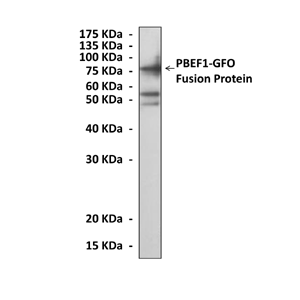Anti-PBEF1: Mouse PBEF1/Visfatin Antibody |
 |
BACKGROUND Visfatin is encoded by a gene officially now known as nicotinamide phosphoribosyltransferase (NAMPT, Entrez ID: 10135), but previously known as pre-B cell colony–enhancing factor gene, PBEF1. It is a novel adipokine that is secreted by visceral and subcutaneous fat, human bone marrow, liver, and muscle. PBEF1 was primarily considered a factor related to the pre-B cell colony-formation activity of stem cells and was therefore defined as a cytokine, which acts on early B lineage precursor cells. Visfatin has a calculated molecular mass of 52 kDa with deduced 473 amino acids and was recently shown to be involved in the development of obesity-associated insulin resistance and type 2 diabetes mellitus in human and animal models. The concentration of Visfatin in plasma increases during the development of obesity, and it was shown to exert insulin-mimetic effects in cultured myocytes and adipocytes and to lower plasma glucose concentrations in mice. Furthermore, plasma Visfatin was also found to be elevated in patients with type 2 diabetes.2
Insulin resistance and deficiency of beta cell function are 2 principal characteristics of type 2 diabetes mellitus. Evidence from animal and in vitro experiments suggests that Visfatin is one of the factors involved in the complex network that controls insulin resistance. Currently, there is sufficient evidence to consider that Visfatin is expressed by the macrophages infiltrating adipose tissue and is produced in response to inflammatory signals. It was shown that Visfatin also activates human leukocytes and induces cytokine production. In CD14+ monocytes, Visfatin induces the production of IL-1beta, TNF-alpha, and especially IL-6 and enhances the surface expression of the co-stimulatory molecules CD54, CD40 and CD80. Moreover, Visfatin induced leukocyte adhesion to endothelial cells and the aortic endothelium by induction of the cell adhesion molecules, ICAM-1 and VCAM-1. Promoter analysis revealed that Visfatin-mediated induction of CAMs is mainly regulated by nuclear factor-kappaB (NF-kappaB). Visfatin can be considered a new proinflammatory adipocytokine.3 In addition Visfatin acts to promote vascular smooth muscle cell maturation and inhibite neutrophil apoptosis. Recently, it was reported that PBEF1 levels may be an efficient and accurate indicator of tumor presence and grade and a potential prognostic marker in high grade neoplasms. Thus, PBEF1 may be involved in cancer development, particularly astrocytoma.4
Insulin resistance and deficiency of beta cell function are 2 principal characteristics of type 2 diabetes mellitus. Evidence from animal and in vitro experiments suggests that Visfatin is one of the factors involved in the complex network that controls insulin resistance. Currently, there is sufficient evidence to consider that Visfatin is expressed by the macrophages infiltrating adipose tissue and is produced in response to inflammatory signals. It was shown that Visfatin also activates human leukocytes and induces cytokine production. In CD14+ monocytes, Visfatin induces the production of IL-1beta, TNF-alpha, and especially IL-6 and enhances the surface expression of the co-stimulatory molecules CD54, CD40 and CD80. Moreover, Visfatin induced leukocyte adhesion to endothelial cells and the aortic endothelium by induction of the cell adhesion molecules, ICAM-1 and VCAM-1. Promoter analysis revealed that Visfatin-mediated induction of CAMs is mainly regulated by nuclear factor-kappaB (NF-kappaB). Visfatin can be considered a new proinflammatory adipocytokine.3 In addition Visfatin acts to promote vascular smooth muscle cell maturation and inhibite neutrophil apoptosis. Recently, it was reported that PBEF1 levels may be an efficient and accurate indicator of tumor presence and grade and a potential prognostic marker in high grade neoplasms. Thus, PBEF1 may be involved in cancer development, particularly astrocytoma.4
REFERENCES
1. Sommer, G. et al: Clin. Sci. 115:13-23, 2008
2. Paschou, P. et al: Cytokine 51:25-27, 2010
3. Moschen, A. R. et al: J. Immunol. 178:1748-58, 2007
4. Reddy, P.S. et al: Cancer Biology & Therapy 7:665-670, 2008
2. Paschou, P. et al: Cytokine 51:25-27, 2010
3. Moschen, A. R. et al: J. Immunol. 178:1748-58, 2007
4. Reddy, P.S. et al: Cancer Biology & Therapy 7:665-670, 2008
Products are for research use only. They are not intended for human, animal, or diagnostic applications.
Параметры
Cat.No.: | CP10197 |
Antigen: | Purified recombinant human Visfatin. |
Isotype: | Mouse IgG1 |
Species & predicted species cross- reactivity ( ): | Human |
Applications & Suggested starting dilutions:* | WB 1:1000 IP 1:50 IHC n/p ICC n/p FACS n/p |
Predicted Molecular Weight of protein: | 52 kDa |
Specificity/Sensitivity: | Detects Visfatin proteins without cross-reactivity with other family members. |
Storage: | Store at -20°C, 4°C for frequent use. Avoid repeated freeze-thaw cycles. |
*Optimal working dilutions must be determined by end user.
Документы
Информация представлена исключительно в ознакомительных целях и ни при каких условиях не является публичной офертой








